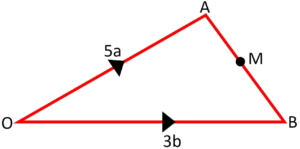Vectors Questions, Properties and Step-by-Step Examples
Vectors
- Vectors are an important tool of Mathematics and are widely used in disciplines like Physics, Engineering, Computer Science etc.
- Vectors are quite important in linear algebra; they provide an excellent vehicle for tackling systems of linear equations and transforming objects.
In this article, we will discuss:
- What is a Vector?
- We will explore how they are different from scalars, and how to perform vector operations such as addition, subtraction, and multiplication.
Here is one more link to practice a few extra questions: Maths Genie Vectors Questions
What is a Vector?
- Vector is quantity that has both magnitude as well as direction.
- The vectors can also be represented geometrically using arrows If we take an arrow as a representation of the vector than the length of this arrow gives the magnitude of the vector and direction of this arrow gives the direction of the vector. For example, consider the following vector:
This vector has a magnitude of 5 and its direction is same as vector (3, 4). Vectors can have as many components as needed, however most commonly they will consist of two components.
Vector vs Scalar
- In mathematics, a scalar is that type of quantity which has only magnitude with no direction associated with it. That is why time, temperature and mass are often classified as scalars.
- Vectors also have an attribute known as magnitude while confirming the presence of direction in their attribute. For instance, the measurement of the temperature of a room is a scalar measurement though the velocity and direction of wind are vector measurements.
Vectors Addition and Subtraction
- It is to be noted that here, addition as well as subtraction of vectors are carried out in each component.
- When combining vectors it is done by addition or subtraction and the two vectors are added or subtracted in terms of their components.
- For example, consider the following vectors:
u = (1, 2) ;v = (3, 4)
- The sum of these vectors is:
u + v = (1+3, 2+4) = (4, 6)
- The difference between these vectors is:
u – v = (1-3, 2-4) = (-2, -2)
Vectors Multiplication
- There are two types of vector multiplication: are dot product and cross product. However, in this article we will only discuss on vector multiplication by a scalar.
- Scalar multiplication of vector simply means that you multiply each of the component of the vector with the scalar.
- For example, consider the vector:
v = (3, 4)
Multiplying this vector by the scalar 2 gives:
2v = (23, 24) = (6, 8)
This has the effect of scaling the vector by a factor of 2.
Conclusion
- All in all, vectors are one of the most important and widely used components of mathematics with its applications in various fields.
- Vector computation such as vector addition, subtraction and multiplication is very important in most mathematics and scientific disciplines.
Practice Questions: Vectors
Question 1: Given vector v = (2, 3), calculate its magnitude.
Question 2: Given vector u = (-1, 5) and vector v = (3, -2), find the sum u + v.
Question 3: Given vector a = (4, -2) and vector b = (-1, 3), find the difference a – b.
Question 4: Given vector u = (2, 3) and scalar k = 4, find the scalar multiplication k x u.
Question 5: Given vector v = (3, 1), find the unit vector in the same direction as v.
Question 6: Given vector u = (1, 2) and vector v = (4, -1), find the dot product u x v.
Question 7: Given vector u = (2, -3) and vector v = (4, 1), find the magnitude of the vector sum u + v.
Question 8: Given vector u = (3, -1) and vector v = (-2, 5), find the scalar projection of u onto v.
Question 9:

OA=5a
OB=3b
M is the midpoint of AB
(a) Find, in terms of a and b, the vector AB
(b) Find, in terms of a and b, the vector AM
(c) Find, in terms of a and b, the vector OM
Question 10: Given vector v = (5, -3), find a vector that is parallel to v but has half its magnitude.
Solutions:
Question 1: Given vector v = (2, 3), calculate its magnitude.
Solution:
The magnitude of vector v = (2, 3) is calculated using the formula:
|v| = √(22 + 32)
= √(4 + 9)
= √13.
Question 2: Given vector u = (-1, 5) and vector v = (3, -2), find the sum u + v.
Solution:
The sum of vectors u = (-1, 5) and v = (3, -2) is calculated by adding their corresponding components:
u + v = (-1 + 3, 5 + (-2))
= (2, 3).
Question 3: Given vector a = (4, -2) and vector b = (-1, 3), find the difference a – b.
Solution:
The difference of vectors a = (4, -2) and b = (-1, 3) is calculated by subtracting their corresponding components:
a – b = (4 – (-1), -2 – 3)
= (5, -5).
Question 4: Given vector u = (2, 3) and scalar k = 4, find the scalar multiplication k x u.
Solution:
The scalar multiplication of scalar k = 4 and vector u = (2, 3) is calculated by multiplying each component of the vector by the scalar:
k x u = (4 x 2, 4 x 3)
= (8, 12).
Question 5: Given vector v = (3, 1), find the unit vector in the same direction as v.
Solution:
The unit vector in the same direction as vector v = (3, 1) is calculated by dividing the vector by its magnitude:
|v| = √(32 + 12)
= √(9 + 1)
= √10.
The unit vector is then v̂ = (3/√10, 1/√10).
Question 6: Given vector u = (1, 2) and vector v = (4, -1), find the dot product u x v.
Solution:
The dot product of vectors u = (1, 2) and v = (4, -1) is calculated by multiplying their corresponding components and summing the results:
u x v = 1 x 4 + 2 x (-1)
= 4 – 2
= 2.
Question 7: Given vector u = (2, -3) and vector v = (4, 1), find the magnitude of the vector sum u + v.
Solution:
The vector sum of u = (2, -3) and v = (4, 1) is calculated by adding their corresponding components:
u + v = (2 + 4, -3 + 1)
= (6, -2).
The magnitude of vector u + v = (6, -2) is calculated using the formula:
|u + v| = √(62 + (-2)2)
= √(36 + 4)
= √40
= 2√10.
Question 8: Given vector u = (3, -1) and vector v = (-2, 5), find the scalar projection of u onto v.
Solution:
The scalar projection of vector u = (3, -1) onto vector v = (-2, 5) is calculated using the formula:
Scalar projection of u onto v = |u| cos(θ),
Here, θ represents the angle formed between vectors u and v.
First, calculate the dot product:
u · v = 3 x (-2) + (-1) x 5 = -6 – 5 = -11.
Then, calculate the magnitude of u:
|u| = √(32 + (-1)2)
= √(9 + 1)
= √10.
Now, substitute these values into the formula:
Scalar projection of u on to
v = (-11) / √10 ≈ -3.48.
Question 9:

OA=5a
OB=3b
M is the midpoint of AB
(a) Find, in terms of a and b, the vector AB
(b) Find, in terms of a and b, the vector AM
(c) Find, in terms of a and b, the vector OM
Solution:
(a) -5a + 3b
(b) -5/2 a + 3/2 b
(c) 5/2 a + 3/2 b
Question 10: Given vector v = (5, -3), find a vector that is parallel to v but has half its magnitude.
Solution:
To find a vector parallel to v = (5, -3) with half its magnitude, we can scale the vector by multiplying each component by 0.5:
A vector parallel to v with half its magnitude is
u = (0.5 x 5, 0.5 x (-3))
= (2.5, -1.5).

